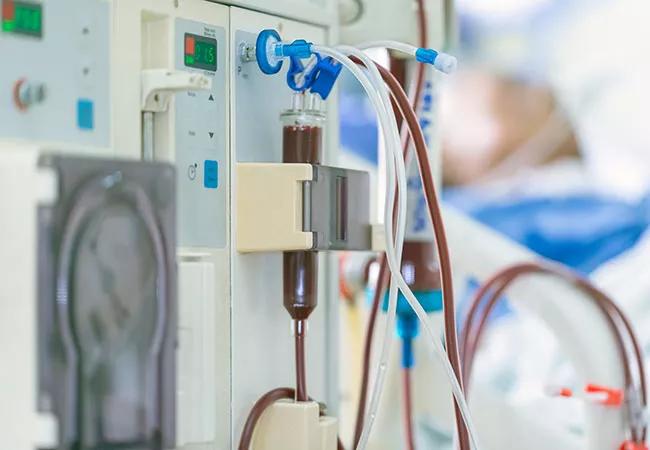Addresses growing need for specialists in dialysis vascular access

The road to becoming an interventional nephrologist — a nephrologist specialized in providing comprehensive vascular access care for hemodialysis therapy — is relatively unmarked. There are few formal academic training programs in the U.S.
Advertisement
Cleveland Clinic is a non-profit academic medical center. Advertising on our site helps support our mission. We do not endorse non-Cleveland Clinic products or services. Policy
More often, nephrology trainees or practicing physicians are introduced to the subspecialty through a workshop at a scientific meeting and then seek hands-on training as an apprentice. Apprenticeships are variable, anywhere from six to 12 weeks of shadowing a vascular access specialist, says Tushar J. Vachharajani, MD, Director of Interventional Nephrology at Cleveland Clinic’s Glickman Urological & Kidney Institute.“The trainer can approve the trainee for certification after they’ve completed a predetermined number of procedures on actual patients,” he says.
But that’s just in the U.S. The certification criteria have been even more ill-defined around the globe — until now.
Dr. Vachharajani led a team in establishing a standardized curriculum for training interventional nephrologists worldwide. The project, recently summarized in Kidney International, was done in collaboration with the International Society of Nephrology’s (ISN’s) Interventional Nephrology Working Group.
“The ISN recognizes the growing burden of kidney failure in the U.S. and around the world,” says Dr. Vachharajani, who has been involved with the ISN for more than a decade and served as chair of the Interventional Nephrology Working Group for many years. “As the number of patients with kidney failure is increasing, there aren’t enough interventional nephrologists to provide care, particularly vascular access for the 90% of patients who opt for hemodialysis. The ISN is working to identify gaps like this and find ways to close them.”
Advertisement
Since maintenance hemodialysis was introduced in the early 1960s, vascular access has remained the biggest hurdle in providing quality treatment and maintaining a patient’s quality of life, says Dr. Vachharajani. Part of the problem has been the prevalent fragmented model of care.
“As recently as the 1990s, most general nephrologists in the U.S. weren’t involved with vascular access care,” says Dr. Vachharajani. “More often it was the radiologists, vascular surgeons and general surgeons that managed it. Nephrologists would manage dialysis, but refer patients for treatment of vascular access problems.”
Nearly 80% of U.S. patients start their dialysis treatment with a catheter. A catheter provides immediate access for hemodialysis but at a high cost of increasing risk for infection, sepsis and stenosis of the central veins. For better long-term vascular access, an arteriovenous fistula or arteriovenous graft is preferable to a catheter. However, this type of vascular access is frequently complicated by stenosis and thrombosis, which require repeated balloon angioplasty to restore and maintain adequate blood flow.
“Many times, the nephrologists wouldn’t know how a patient’s vascular access problem had been addressed, or even if the procedures were short- or long-term solutions,” says Dr. Vachharajani. “This fragmented care resulted in increased morbidity, mortality and cost to society.”
Between 2000 and 2003, initiatives by the Centers for Medicare & Medicaid Services and the National Kidney Foundation introduced the concept of multidisciplinary care for these patients. Each member of the care team would know each patient’s care plan and be responsible for ensuring that vascular access remained patent, ensuring more patients had uninterrupted dialysis treatments to help avoid the need for hospitalization. The shifting paradigm in clinical care required training more nephrologists to provide optimal and coordinated vascular care for these patients.
Advertisement
The American Society of Diagnostic and Interventional Nephrology (ASDIN) was founded around the same time, also contributing to improvements in multidisciplinary dialysis access care. Today, out of the approximately 11,000 nephrologists in the U.S., about 466 are ASDIN-certified interventional nephrologists. The exact number of practicing interventional nephrologists remains unknown as there is no requirement to be certified in this specialty.
Even in the U.S., more interventional nephrologists are needed to manage the growing number of patients with kidney failure. The need is greater in low- to middle-income countries, in Asia and Africa for example, where the care burden looms just as large but opportunities for subspecialty training remain limited.
This global challenge is what drove the ISN to propose a standardized training curriculum for interventional nephrology. After three years of work — incorporating insights from dialysis access societies in the U.S., Australia and New Zealand, Asia, India and other regions — the Interventional Nephrology Working Group introduced a two-level training approach.
Level 1 includes didactic e-learning, simulation training on mannequins and an online self-assessment. Level 2 involves shadowing and supervised training, similar to the current apprenticeship model in the U.S.
“Simulation training is one on one with a trainer,” says Dr. Vachharajani. “There’s a checklist of skills that the trainee must master before moving on to level 2. The trainee must show that they’re comfortable and confident with each type of procedure, the devices used and the order of steps. For level 2, trainees are expected to first assist a vascular access specialist and then progress to providing care independently. The trainer assesses their procedural skills and decides when the trainee is ready to be certified.”
Advertisement
The two-level approach is intended as a roadmap for national nephrology societies to customize training and implementation plans based on regional credentialing and licensing regulations.
“In some countries, urologists and even orthopaedic surgeons perform vascular access interventions,” says Dr. Vachharajani. “Credentialing bodies can adapt the ISN’s curriculum to the nuances of their region.”
The ISN has begun certifying regional centers to provide training in line with the new curriculum. In January 2021, Cleveland Clinic was among the first 12 centers to be certified as part of this global training network.
“This curriculum is the first step in establishing structured training for interventional nephrologists,” says Dr. Vachharajani. “We wanted to replace the ‘see one, do one, teach one’ approach because it was not sufficient to prepare trainees to perform vascular access procedures. Trainees need much more experience — including with didactics, simulation and hands-on training — to be confident and efficient at providing quality dialysis access care.”
Advertisement
Advertisement

Proteinuria reduction remains the most important treatment target.

IgA nephropathy is a relatively common autoimmune glomerular disease that can be diagnosed only by biopsy

Authors summarize the recent evidence and offer two clinical scenarios

Key considerations when diagnosing and managing severe hyponatremia

Clinicians should individualize dosing practices based on patient risk factors and preferences

Fully-automated process uses preop CT, baseline GFR to estimate post-nephrectomy renal function

Identifying barriers in the renal genetic assessment of Black patients

Getting patients to their goal blood pressure